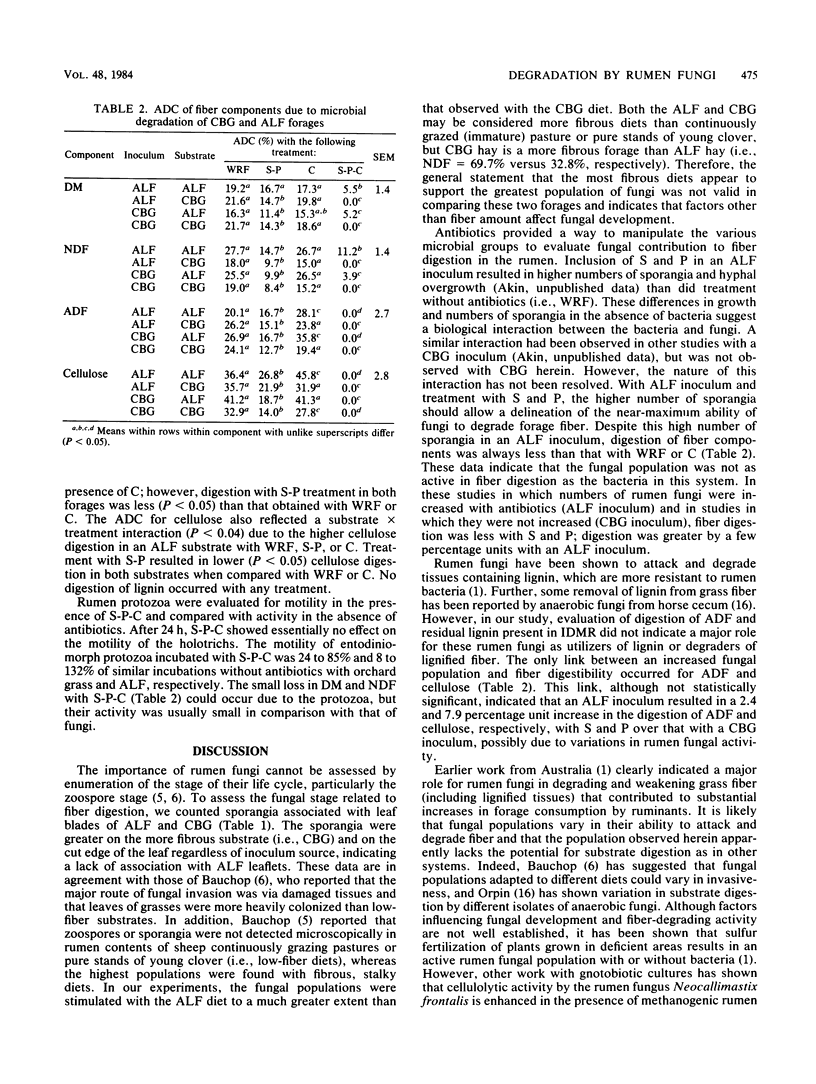Abstract
The role of anaerobic rumen fungi in in vitro forage fiber degradation was determined in a two forage × two inoculum source × five treatment factorial design. Forages used as substrates for rumen microorganisms were Coastal bermuda grass and alfalfa; inoculum sources were rumen fluid samples from a steer fed Coastal bermuda grass hay or alfalfa hay; treatments were whole rumen fluid (WRF), WRF plus streptomycin (0.2 mg/ml of rumen fluid) and penicillin (1.25 mg/ml of fluid), WRF plus cycloheximide (0.5 mg/ml of fluid), WRF plus streptomycin, penicillin, and cycloheximide, and McDougall buffer. Populations of fungi as shown by sporangial development were greater on bermuda grass leaves than on alfalfa leaflets regardless of inoculum source. However, endogenous fungal populations were greater from the alfalfa hay inoculum. Cycloheximide inhibited the fungi, whereas streptomycin and penicillin, which inhibit bacterial populations, resulted in an increase in numbers of sporangia in the alfalfa inoculum, suggesting an interaction between bacteria and fungi. Bacteria (i.e., WRF plus cycloheximide) were equal to the total population in degrading dry matter, neutral-detergent fiber (NDF), acid-detergent fiber (ADF), and cellulose for both inocula and both forages. Degradation of dry matter, NDF, ADF, and cellulose by anaerobic fungi (i.e., WRF plus streptomycin and penicillin) was less than that due to the total population or bacteria alone. However, NDF, ADF, and cellulose digestion was 1.3, 2.4, and 7.9 percentage units higher, respectively, for bermuda grass substrate with the alfalfa versus bermuda grass inoculum, suggesting a slight benefit by rumen fungi. No substantial loss of lignin (72% H2SO4 method) occurred due to fungal degradation. The most active fiber-digesting population in the rumen was the bacteria, even when streptomycin and penicillin treatment resulted in an increase in rumen fungi over untreated WRF. The development of large numbers of sporangia on fiber may not indicate a substantial role as digesters of forage.
Full text
PDF



Selected References
These references are in PubMed. This may not be the complete list of references from this article.
- Akin D. E., Gordon G. L., Hogan J. P. Rumen bacterial and fungal degradation of Digitaria pentzii grown with or without sulfur. Appl Environ Microbiol. 1983 Sep;46(3):738–748. doi: 10.1128/aem.46.3.738-748.1983. [DOI] [PMC free article] [PubMed] [Google Scholar]
- Amos H. E., Akin D. E. Rumen protozoal degradation of structurally intact forage tissues. Appl Environ Microbiol. 1978 Sep;36(3):513–522. doi: 10.1128/aem.36.3.513-522.1978. [DOI] [PMC free article] [PubMed] [Google Scholar]
- Bauchop T., Clarke R. T. Attachment of the ciliate Epidinium Crawley to plant fragments in the sheep rumen. Appl Environ Microbiol. 1976 Sep;32(3):417–422. doi: 10.1128/aem.32.3.417-422.1976. [DOI] [PMC free article] [PubMed] [Google Scholar]
- Bauchop T. Rumen anaerobic fungi of cattle and sheep. Appl Environ Microbiol. 1979 Jul;38(1):148–158. doi: 10.1128/aem.38.1.148-158.1979. [DOI] [PMC free article] [PubMed] [Google Scholar]
- Bauchop T. The rumen ciliate epidinium in primary degradation of plant tissues. Appl Environ Microbiol. 1979 Jun;37(6):1217–1223. doi: 10.1128/aem.37.6.1217-1223.1979. [DOI] [PMC free article] [PubMed] [Google Scholar]
- Joblin K. N. Isolation, enumeration, and maintenance of rumen anaerobic fungi in roll tubes. Appl Environ Microbiol. 1981 Dec;42(6):1119–1122. doi: 10.1128/aem.42.6.1119-1122.1981. [DOI] [PMC free article] [PubMed] [Google Scholar]
- McDougall E. I. Studies on ruminant saliva. 1. The composition and output of sheep's saliva. Biochem J. 1948;43(1):99–109. [PMC free article] [PubMed] [Google Scholar]
- Mountfort D. O., Asher R. A., Bauchop T. Fermentation of Cellulose to Methane and Carbon Dioxide by a Rumen Anaerobic Fungus in a Triculture with Methanobrevibacter sp. Strain RA1 and Methanosarcina barkeri. Appl Environ Microbiol. 1982 Jul;44(1):128–134. doi: 10.1128/aem.44.1.128-134.1982. [DOI] [PMC free article] [PubMed] [Google Scholar]
- Orpin C. G. Invasion of plant tissue in the rumen by the flagellate Neocallimastix frontalis. J Gen Microbiol. 1977 Feb;98(2):423–430. doi: 10.1099/00221287-98-2-423. [DOI] [PubMed] [Google Scholar]
- Orpin C. G. Isolation of cellulolytic phycomycete fungi from the caecum of the horse. J Gen Microbiol. 1981 Apr;123(2):287–296. doi: 10.1099/00221287-123-2-287. [DOI] [PubMed] [Google Scholar]
- Yoder R. D., Trenkle A., Burroughs W. Influence of rumen protozoa and bacteria upon cellulose digestion in vitro. J Anim Sci. 1966 Aug;25(3):609–612. doi: 10.2527/jas1966.253609x. [DOI] [PubMed] [Google Scholar]


